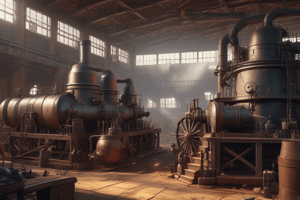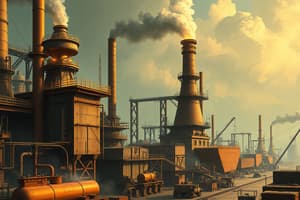Podcast
Questions and Answers
What was a significant factor that contributed to the Wall Street Crash of 1929?
What was a significant factor that contributed to the Wall Street Crash of 1929?
- Increased government regulations on corporations
- A sudden decrease in international trade
- A major shift in agricultural production
- Expansion of consumer credit and debt (correct)
Which president is credited with fostering an economic environment known as 'Coolidge Prosperity'?
Which president is credited with fostering an economic environment known as 'Coolidge Prosperity'?
- Warren G. Harding
- Woodrow Wilson
- Herbert Hoover
- Calvin Coolidge (correct)
What cultural movement is highlighted by the emergence of flappers during the 1920s?
What cultural movement is highlighted by the emergence of flappers during the 1920s?
- Consumerism
- Traditionalism
- Industrialism
- Liberalism and the rejection of gender norms (correct)
What was a significant effect of the market speculation and overconsumption in the 1920s?
What was a significant effect of the market speculation and overconsumption in the 1920s?
What major event marked the end of prosperity in the U.S. during the late 1920s?
What major event marked the end of prosperity in the U.S. during the late 1920s?
What was a significant impact of the Bessemer steel process during the Second Industrial Revolution?
What was a significant impact of the Bessemer steel process during the Second Industrial Revolution?
Which of the following best describes the workplace conditions during the Second Industrial Revolution?
Which of the following best describes the workplace conditions during the Second Industrial Revolution?
What was the ideal business organization strategy aimed at controlling a market during this era?
What was the ideal business organization strategy aimed at controlling a market during this era?
What role did nativism play during the Industrial Revolution?
What role did nativism play during the Industrial Revolution?
What was one of the major tragedies that influenced labor safety regulations?
What was one of the major tragedies that influenced labor safety regulations?
Which factor contributed to the influx of unskilled laborers during the Second Industrial Revolution?
Which factor contributed to the influx of unskilled laborers during the Second Industrial Revolution?
What was a common response by workers seeking to improve their conditions during the Second Industrial Revolution?
What was a common response by workers seeking to improve their conditions during the Second Industrial Revolution?
What was the role of the Sherman Antitrust Act during this period?
What was the role of the Sherman Antitrust Act during this period?
What was the primary purpose of the Page Act of 1875?
What was the primary purpose of the Page Act of 1875?
Which of the following best describes urbanization during the late 1800s in the United States?
Which of the following best describes urbanization during the late 1800s in the United States?
What was a significant outcome of the Spanish-American War for the United States?
What was a significant outcome of the Spanish-American War for the United States?
What ideology supported nativism during the time period discussed?
What ideology supported nativism during the time period discussed?
What role did muckrakers play in urban areas during the late 19th century?
What role did muckrakers play in urban areas during the late 19th century?
Which act restricted immigration specifically from China?
Which act restricted immigration specifically from China?
What contributed to the United States' shift towards imperialism after the Civil War?
What contributed to the United States' shift towards imperialism after the Civil War?
What was a consequence of American Yellow Journalism during the Spanish-American War?
What was a consequence of American Yellow Journalism during the Spanish-American War?
During the Spanish-American War, what factor caused more fatalities than the actual battles?
During the Spanish-American War, what factor caused more fatalities than the actual battles?
What was the Anti-Imperialist League's stance regarding American foreign involvement?
What was the Anti-Imperialist League's stance regarding American foreign involvement?
What were the primary goals of the Populist Party?
What were the primary goals of the Populist Party?
Which candidate is known for co-opting the free silver issue in the 1896 election?
Which candidate is known for co-opting the free silver issue in the 1896 election?
What social issues were addressed during the Progressive Era?
What social issues were addressed during the Progressive Era?
Who coined the term 'muckrakers'?
Who coined the term 'muckrakers'?
How did muckrakers positively influence society?
How did muckrakers positively influence society?
What was one of the main causes of World War I?
What was one of the main causes of World War I?
What event prompted the United States to declare war in April 1917?
What event prompted the United States to declare war in April 1917?
What outcome occurred as a result of the Treaty of Versailles?
What outcome occurred as a result of the Treaty of Versailles?
Which of the following groups were primarily involved in deciding the terms of the post-WWI world during the Paris Peace Conference?
Which of the following groups were primarily involved in deciding the terms of the post-WWI world during the Paris Peace Conference?
What legislation resulted from Upton Sinclair's work, 'The Jungle'?
What legislation resulted from Upton Sinclair's work, 'The Jungle'?
Flashcards are hidden until you start studying
Study Notes
The Second Industrial Revolution
- Transformation of U.S. industry saw mechanization and improved manufacturing techniques.
- Bessemer steel process played a crucial role in steel production efficiency.
- Scientific management aimed to enhance labor productivity, often leading to worker dehumanization.
- Business strategies evolved, focusing on monopolies via horizontal and vertical integration to eliminate competition.
- Sherman Antitrust Act introduced late in the century to regulate anti-competitive practices.
Labor Conditions and Social Changes
- Significant industrial job growth post-Civil War; many unskilled workers were immigrants, women, and children.
- Absence of a minimum wage led to poverty wages for men, despite long working hours.
- Workplaces were hazardous with high accidental death rates; no disability support for injured workers.
- The Triangle Shirtwaist Factory fire in 1911 led to increased fire safety regulations.
- Labor unions formed as workers sought to improve conditions; child labor saw a gradual decline.
Nativism and Immigration
- Rise of xenophobia during the Gilded Age fostered suspicion against immigrants, particularly the Chinese and Eastern Europeans.
- Nativism favored established inhabitants over immigrants, leading to restrictive policies.
- Key immigration laws: Page Act of 1875 and the Chinese Exclusion Act restricted certain groups and required identification.
- Immigrants sought refuge from persecution, finding opportunities mainly through eastern ports like Ellis Island.
Urbanization
- Late 19th and early 20th centuries saw migration to cities for better work and leisure opportunities.
- Rapid urban growth often outpaced infrastructure development, leading to inadequate services.
- Cities became ethnically segregated slums plagued by disease; muckrakers raised awareness of these issues.
- Urban planning efforts initiated reforms in housing safety, sanitation, public services, and transportation.
Imperialism
- U.S. traditionally isolationist before the late 19th century, shifting towards global influence after the Civil War.
- Social Darwinism justified American expansion, promoting the idea of controlling 'lesser developed' nations.
- Alaska and Hawaii were early examples of U.S. territorial expansion, followed by acquisitions post-Spanish-American War.
- Opposition to imperialism emerged, exemplified by the formation and eventual dissolution of the Anti-Imperialist League.
Spanish-American War
- War lasted from April to July 1898, driven by interests in Cuban independence and U.S. territorial expansion.
- Yellow Journalism sensationalized events, influencing public sentiment and rallying support for war.
- Major battles took place in the Caribbean and Pacific; diseases claimed more lives than combat.
- Treaty of Paris (1898): Cuba gained independence, U.S. acquired Puerto Rico, Guam, and paid $20 million for the Philippines.
- Resulted in U.S. emergence as a world power and ongoing conflict with the Philippines for their independence.
Challenges for American Farmers
- Gilded Age policies favored industrial growth, adversely affecting farmers' economic stability.
- Farmers organized through the Granger movement and Farmers' Alliances, promoting reforms against monopolistic practices.
- Formation of the Populist Party advocating for monetary and electoral reforms gained prominence in the 1890s.
- The free silver issue and other reforms led to significant political influence, despite eventual decline following the 1896 election.
Progressivism
- Aimed at rectifying social issues, with leaders like Theodore Roosevelt and William Jennings Bryan.
- Focused on reforms: labor rights, women's suffrage, and social justice; women's voting rights gained momentum.
- Progressivism primarily addressed issues within white communities, sidelining the challenges faced by people of color.
- Served as a foundation for future reforms in civil rights and equality.
Muckraking and Corruption
- Muckrakers exposed political corruption and corporate malpractices, catalyzing public awareness and action.
- Notable journalists: Lincoln Steffens, Ida Tarbell, Upton Sinclair; documented societal issues and fueled reform movements.
- Social changes led to the passage of laws such as the Pure Food and Drug Act and the Meat Inspection Act.
- Decline in muckraking popularity by 1912, yet the societal reforms remained influential.
World War I
- Primary causes included alliances (Triple Entente vs. Triple Alliance), nationalism, militarism, and imperialism.
- U.S. maintained neutrality influenced by sympathies towards the Allies until several provocations prompted its entry.
- Factors leading to U.S. involvement: unrestricted submarine warfare, propaganda, and the Zimmermann Telegram.
- Post-war, U.S. presence significantly shifted the balance of power and influenced the Treaty of Versailles outcomes.
The Roaring Twenties
- Economic growth and cultural shifts characterized the 1920s, driven by technological advancements and consumer culture.
- Corporations utilized new manufacturing techniques, resulting in an explosion of consumer products and reliance on credit.
- Despite prosperity, overconsumption and market speculation set the stage for the 1929 Wall Street Crash.
- The decade ended with financial turmoil, marking the onset of the Great Depression.
Political Landscape of the 1920s
- Shift away from progressive politics; the return to normalcy was heralded by Warren G. Harding’s presidency.
- Harding's administration featured tax cuts and economic recovery, marred by scandals like the Teapot Dome.
- Herbert Hoover continued pro-business policies but faced disastrous repercussions following the stock market crash.
Studying That Suits You
Use AI to generate personalized quizzes and flashcards to suit your learning preferences.




